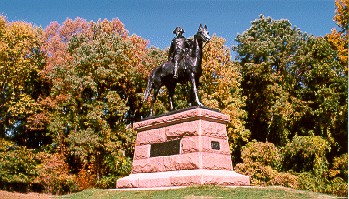Military: Revolutionary War

Valley Forge National Historical Park
Valley Forge is perhaps the best-known place name associated with the American Revolution. To truly enjoy the park, it is important that you understand the significance of the events associated with the winter encampment of 1777-78. The National Park Service provides various programs, tours, and other interpretive activities to help you grasp more fully the dramatic story Valley Forge has to tell. Park Rangers make every effort to accommodate all visitors in these presentations. It is the goal of the National Park Service to make the park accessible to all visitors.
On December 19, 1777, when Washington's army marched into camp at Valley Forge, tired, cold, and ill-equipped, it was lacking in much of the training essential for consistent success on the battlefield. On June 19, 1778, after a six-month encampment, this same army emerged to pursue and successfully engage Lt. Gen. Sir Henry Clinton's British army at the Battle of Monmouth in New Jersey. The ordered ranks, martial appearance, revived spirit, and fighting skill of the American soldiers spoke of a great transformation having occurred amidst the cold, sickness, and hardship that was Valley Forge.
The man most responsible for this transformation was Friedrich Wilhelm von Steuben, onetime member of the elite General Staff of Frederick the Great, king of Prussia. No longer in the Prussian army, indeed without employment of any kind, von Steuben offered his military skills to the patriot cause. When he arrived at Valley Forge from France on February 23, 1778, he was armed with a letter of introduction from Benjamin Franklin. Washington saw great promise in the Prussian and almost immediately assigned him the duties of Acting Inspector General with the task of developing and carrying out an effective training program.
- Adams National Historic Site
- Boston National Historical Park
- Colonial National Historical Park: Yorktown
- Cowpens National Battlefield
- Fort Stanwix National Monument
- Historic Camden*
- George Rogers Clark National Historical Park
- Guilford Courthouse National Military Park
- Independence National Historical Park
- Kings Mountain National Military Park
- Longfellow National Historic Site
- Minute Man National Historical Park
- Moores Creek National Battlefield
- Morristown National Historical Park
- Ninety Six National Historic Site
- Overmountain Victory National Historic Trail*
- Saint Paul's Church National Historic Site
- Saratoga National Historical Park
- Thaddeus Kosciuszko National Memorial
- Valley Forge National Historical Park
- American Revolution in Kingston, New York
- George Washington Birthplace - Historical Handbook Series
- Guilford Courthouse - Historical Handbook Series
- Guide to Canadian Sources Related to Southern Revolutionary War National Parks (2002) (pdf)
- Historical Statements Concerning the Battles of Kings Mountain and Cowpens
- Independence National Historical Park - Historical Handbook Series
- Kings Mountain National Military Park - Historical Handbook Series
- Lighting Freedom's Flame
- National Park Service Museum Collections of the American Revolutionary War
- Morristown: A Military Capital of the American Revolution - Historical Handbook Series
- People of the Revolution
- Saratoga National Historical Park - Historical Handbook Series
- Southern Campaigns of the Revolutionary War (pdf)
- Southern Campaign of the American Revolution
- Teaching With Historic Places: Military History Lesson Plans
- The American Revolution
- The Battle of Camden, South Carolina
- Washington-Rochambeau Trail Initiative (pdf)
- Yorktown and the Siege of 1781 - Historical Handbook Series
Related Links: